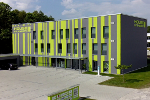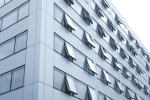The Passive House Institute (PHI) is an independent research institute that has played an especially crucial role
in the development of the Passive House concept - the only internationally recognised, performance-based energy standard in construction. Learn more about the Institute and its work.
![]()
Press releases
|
|
Step-by-step towards EnerPHit |
![]()
|
|
Photos: Klinikum Frankfurt Höchst |
Operation Passive House Clinic |
![]()
|
|
Photo above: H.Dimko |
From kindergartens to retirement homes The Passive House Institute is looking forward to Vienna where the 21st International Passive House Conference will be taking place next year. The date and venue for the Conference have now been confirmed: experts in energy efficient construction will convene at the Messe Wien Congress Centre on the 28th and 29th April 2017. The theme for the 21st Conference will be "Passive House for all". The Call for Papers has begun. www.passivehouseconference.org // more |
![]()
News in brief
|
Smiling faces in Aberdeen |
![]()
Press releases
Passive House Institute joins NAPHN in New York for annual conference |
|
|
Passive House Conference presents solutions for buildings of the future The Passive House Standard combines maximum efficiency with optimal comfort. How this works, was demonstrated by experts from all over the world on 22 and 23 April during the International Passive House Conference in Darmstadt. This event also marked an anniversary: 25 years ago, the world's first Passive House building was built just a few kilometres away from the congress centre – and a brand new study, presented at the Conference, proves the sustainability of the concept. more |
|
|
New database provides overview of Passive House components Whether just browsing or to find a specific product – a new online database provides a detailed overview of components for Passive House construction. All |
|
|
"Active for more comfort" - Passive House brochure as online flipbook How does a Passive House work? Which requirements exist with regard to components, planning, design, and project implementation? What is it like to live in a Passive House, what has already been built, and why are Passive Houses such an attractive investment? In order to competently answer such questions, the International Passive House Association (iPHA) has created the informational brochure "Active for more comfort". A new edition of this brochure is now available as an online flipbook. |
|
|
Passive House Institute launches e-learning program With a tablet at home or with a smartphone during the daily commute – a new e-learning program is making basic Passive House training more comfortable than ever before. The video-based online modules are equally suitable as an introduction for laypersons and as preparatory material for courses aimed at certification as a Passive House Designer or Consultant. The individual chapters deal with general questions as well as with specific examples of planning for building services systems and the building envelope. more |
|
|
Designing sustainable buildings made fun: PHPP 9 now available The tried and tested PHPP tool for designing energy efficient buildings is available in a brand-new version. This upgrade not only allows reliable calculation of the energy demand in accordance with internationally applicable criteria. It takes into account energy generation on or near the building as well. The new features also include innovative options, for example for heat recovery from shower water or for profitability calculations. The practical use of the tool is facilitated by means of automatic verification and plausibility checks. more |
|
|
Component Award for exemplary ventilation concepts for retrofits The winners of the Component Award 2016 for ventilation solutions in residential buildings have been selected. The first prize goes to a concept by the Austrian manufacturer Pichler. A joint second prize will be granted to Vaventis and Michael Tribus Architecture. The approaches for building retrofits selected by a jury are not only characterised by a high level of energy efficiency, but also by their economic viability. The presentation of the Award took place at the 20th International Passive House Conference. more |
|
|
New Passive House office building in Frankfurt now certified Curved façades, but a straightforward energy concept: a new office building in Frankfurt, Germany, clearly shows the potential of sustainable building design, with an architectural style that is not only elegant but also intelligent. The result is a 90 percent reduced heating demand and perceptibly increased comfort due to high indoor air quality. The building thus meets with the criteria for the Passive House Standard. Details were discussed during excursions as part of the International Passive House Conference 2016. more |
|
|
World's first Passive House Premium now certified One of the world's most sustainable buildings stands in Bavaria: as the first of its kind, a mixed residential and commercial project in the town of Kaufbeuren has met the criteria for a Passive House Premium certification. With a heating demand of only 8 kWh/m²a, it is uniquely energy efficient. At the same time, a 250 m² photovoltaic system on the roof produces renewable energy. The doors of this new building were open to the public on 14 and 15 November within the framework of the international Passive House Days 2015. more |
|
|
World's largest building retrofitted to EnerPHit Standard now certified A completely modernized university building in Innsbruck, Austria demonstrates the energy saving potential available with refurbishments. Through integrated planning, the heating demand of the building was reduced from 180 kWh/m²a to just 21 kWh/m²a. The project thus meets the criteria of the EnerPHit Standard for retrofits with Passive House components – this standard, introduced by the Passive House Institute, is specially tailored to the particularities of retrofit projects. The certificate was presented at the official reopening. more |
|
|
New study shows cost saving potential for indoor swimming pools Passive House efficiency is a model for the future also for indoor swimming pools. This is demonstrated in a new report on the energy consumption in the "Bambados" in Germany. The running costs for this leisure pool are far below average. The concept is thus successfully providing an opportunity for financial savings, especially relevant for municipalities with limited budgets. The full report is now available online (in German). Further details were presented at the International Passive House Conference in 2016 in Darmstadt. more |
|
|
Monitoring confirms energy efficiency of Passive House city district The Passive House district of Bahnstadt in Heidelberg (Germany) has passed the test: according to a report on recent measurements, the values being strived for in relation to energy efficiency were met in full. In 2014, the average consumption of 1260 housing units with a living area of more than 75 000 m² was 14.9 kWh/(m²a). The statistically high number of projects built by different property developers and architects convincingly shows that a successful large- scale implementation of the Passive House Standard is possible. more |
|
|
New architecture book presents "Passive House Award" winners A new book showcasing the winners and finalists of the international "Passive House Award" shows that energy efficient construction is not only profitable, it is also an enrichment for architecture. The book is available in a bound version and in digital form as an online flipbook. All of the award-winning buildings are presented with many photographs and illustrations. Technical details which are relevant for the energy balance are also explained in detail. In addition to the book, there is a poster exhibition on the Award. more |
|
|
First multi-unit residential building certified to Passive House Plus The combination of energy efficiency and renewables is the future-proof solution for all buildings, including multi-storey projects – this is demonstrated with a new build in Innsbruck, Austria: the apartment complex is the first of its kind to be certified as a Passive House Plus building. This concept is not just based on a theoretical annual energy balance, which is misleading in practice; instead, the actual amount of regionally and seasonally available renewable energy is taken into account. more |
|
|
New designPH takes Passive House planning to a whole new level Passive House planning has never been more convenient. The new designPH, a 3D model interface developed by the Passive House Institute, allows for graphic input of energy related design data. Details relating to the thermal building envelope and shading are entered automatically and can be optimised if necessary. The treated floor area can be gradually refined in order to simplify the design process. The results can be exported into the Passive House Planning Package (PHPP) with just a few clicks. more / order now |
![]()
For regular Passive House related news please follow the International Passive House Association (iPHA) on
Twitter and Facebook or the Passive House Institute on LinkedIn.
| Passive House in Social Media |
| Events |
![]() 13th Passive House Days
13th Passive House Days
11 to 13 Nov 2016, worldwide
![]() read more
read more
![]()
28 - 29 April 2017, Vienna
![]() read more
read more
| Component Database |
 Passive House
Passive House
Component Database
read more
| Projects |
| New developments |
![]() designPH
designPH
read more
![]() PHPP 9 (2015)
PHPP 9 (2015)
read more
 Seals for Certified Passive House Components
Seals for Certified Passive House Components
read more
 Passive House Classes,
Passive House Classes,
Classic, Plus, Premium
read more
 EnerPHit -
EnerPHit -
PHI certification for retrofits
read more
 Wall plaque
Wall plaque
for certified Passive Houses
read more
| Press releases |
| Research & Literature |
![]() Passive Houses for different climate zones
Passive Houses for different climate zones
more
 Retrofits with Passive House components -
Retrofits with Passive House components -
EnerPHit Planner Handbook
(in German)
 Passive House Retail Stores now out
Passive House Retail Stores now out
Overview of contents
(in German)





















